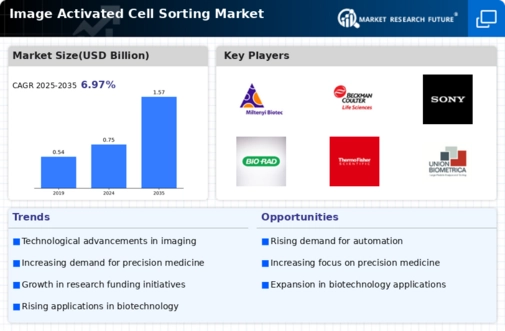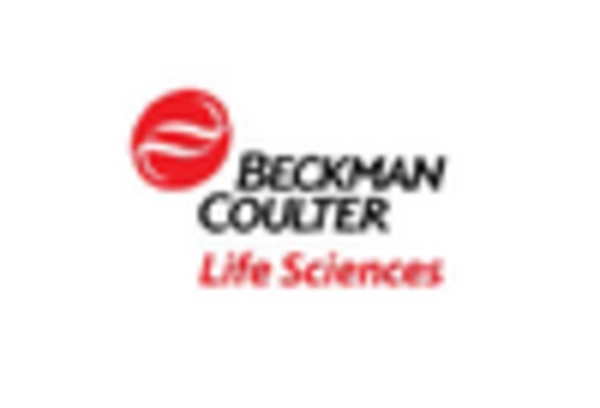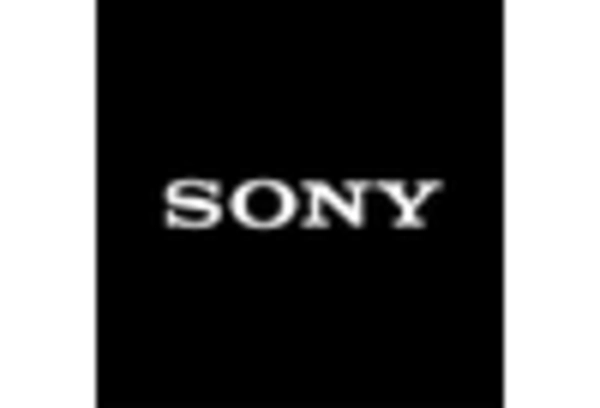Collaborative Research Initiatives
The Image Activated Cell Sorting Market is benefiting from collaborative research initiatives among various stakeholders, including academic institutions, research organizations, and biotechnology firms. These collaborations are fostering innovation and accelerating the development of new technologies in cell sorting. By pooling resources and expertise, these entities are able to tackle complex challenges in cell analysis and sorting. The market is expected to see a boost in growth as these partnerships lead to the introduction of advanced image-activated cell sorting systems. Furthermore, joint research projects often attract funding from governmental and private sectors, which can further enhance the capabilities and reach of image-activated cell sorting technologies. This collaborative approach is likely to create a more dynamic and responsive market environment.
Rising Demand for Personalized Medicine
The Image Activated Cell Sorting Market is significantly influenced by the rising demand for personalized medicine. As healthcare shifts towards more individualized treatment approaches, the need for precise cell sorting technologies becomes paramount. Image-activated cell sorting enables the identification of specific cell populations that can be targeted for tailored therapies. This trend is reflected in the increasing investments in research and development, with the market expected to grow substantially in the coming years. The ability to isolate and analyze cells from patients allows for the development of customized treatment plans, which is likely to enhance patient outcomes. Consequently, the demand for image-activated cell sorting technologies is projected to rise, further driving market expansion.
Regulatory Support and Funding Opportunities
The Image Activated Cell Sorting Market is also experiencing growth due to increased regulatory support and funding opportunities. Governments and regulatory bodies are recognizing the importance of advanced cell sorting technologies in research and clinical applications. This recognition is leading to the establishment of funding programs aimed at supporting innovation in the field. For instance, grants and subsidies are being offered to research institutions that focus on developing new image-activated cell sorting technologies. This financial backing is likely to stimulate research activities and encourage the adoption of these technologies in various applications. As a result, the market is expected to expand, driven by both regulatory support and the influx of funding aimed at enhancing the capabilities of image-activated cell sorting.
Increasing Applications in Biomedical Research
The Image Activated Cell Sorting Market is witnessing an increase in applications across various sectors of biomedical research. The ability to sort and analyze cells based on specific characteristics is proving invaluable in areas such as immunology, oncology, and stem cell research. For instance, the market for cell sorting technologies is anticipated to reach USD 1.5 billion by 2026, driven by the rising need for precise cell analysis in drug development and personalized medicine. Researchers are increasingly relying on image-activated cell sorting to enhance the accuracy of their findings, which is likely to propel market growth. Furthermore, collaborations between academic institutions and biotechnology companies are fostering innovation, thereby expanding the scope of applications for image-activated cell sorting technologies.
Technological Advancements in Imaging Techniques
The Image Activated Cell Sorting Market is experiencing a surge in technological advancements, particularly in imaging techniques. Innovations such as high-resolution imaging and real-time analysis are enhancing the precision of cell sorting processes. These advancements allow researchers to identify and isolate specific cell types with unprecedented accuracy. As a result, the market is projected to grow at a compound annual growth rate of approximately 12% over the next five years. The integration of artificial intelligence and machine learning into imaging systems is also expected to streamline workflows, thereby increasing efficiency in laboratory settings. This technological evolution not only improves the quality of research but also expands the applications of cell sorting in various fields, including cancer research and regenerative medicine.


















Leave a Comment